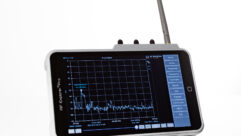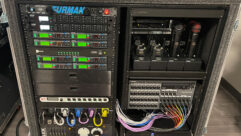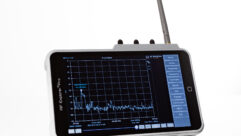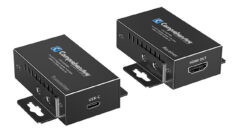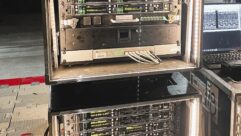LONG-RANGE: RF and cellular communication
Dec 1, 1999 12:00 PM,
Steve Filippini
The standard home has a small, recessed enclosure on the side of thebuilding, usually located near the garage, that provides and protects thetelephone lines that come in from the street. From there, the phone linesare routed throughout the home. The standard security system of today usesthe same telephone line to communicate with the monitoring center when analarm or trouble condition has occurred. The standard burglar (or, as welike to call them, ethically challenged individual) knows that opening theenclosure and cutting the phone line effectively stops all communicationfrom exiting or entering the building.
As cost effective and readily available a phone line communication path canbe, there are limitations that should be understood. If the RJ31X telcoline seizure jack is incorrectly wired, simply lifting the telephonehandset at the home will stop the alarm signal from dialing out. If thetelephone line goes down because of a storm or equipment failure at thephone company, there is no signal path for the security system to follow.Even worse, if the phone company performs a service call at a home orbusiness and accidentally disconnected the phone line to an unsupervisedunit, no one would know until it was too late.
This is not a new concern. Many years ago, when I was still figuring outwhich end of a screwdriver to use, alarm companies were already usingdedicated phone lines that were monitored 24 hours a day by the monitoringcenter. This type of system actually preceded digital dialers and laid downsome of the ground rules for supervising alarm systems. A dedicated phoneline was provided by the phone company, and a device designed to monitorline voltage and continuity were used to ensure line integrity. These typesof systems were called direct wire or DLPD (Direct Line Police Department)and were primarily used in jewelry stores and high-priced product shops.The cost was reasonable at first, but the phone company soon realized thatit was a service and maintenance nightmare and soon raised the cost of theline to a level that was higher than most merchants wanted to spend. Thealternative was digital dialers. Cost effective and easy to tie into,digital dialers quickly became the way to go. That is until phone lineswere cut and were going undetected for days, sometimes months at a time.
Some manufacturers of security premise units figured out that a secondphone line could just as easily backup the first phone line in the event ofa failure. If you think about it, two lines were better than one. Ofcourse, if you are going to cut a phone line, you might as well cut both ofthem. The premise unit would notice the loss of line voltage (not loss ofdial tone), and it would use the good line to dial out a signal to themonitoring center alerting them of a phone line problem. If both lines wereout, the premise unit dialed out into thin air and buzzed at the keypadsuntil someone noticed. This was also enhanced with the introduction of testtimers. Every 24 hours, the premise unit would dial into the monitoringcenter and check in with a signal that said, I’m still communicating.
A full 24 hours is a long time to be without a means of communicatingbefore someone finds out. You could shorten the test timer time to once anhour, if needed, but it would flood the phone lines into the monitoringcenter if all of your premise units tried doing that. Some customers eventhought about going back to the old method of direct wire technology. Thismethod was expensive, and it experienced sporadic continuity problems, butif and when it failed, you knew right away.
Instead of taking a technical stride backwards, someone thought about usingcellular phones as a backup to a land line phone. Cellular technology wasexpensive, but the possibility of two separate communication paths broughtabout some benefits as well. Every phone wire into the building could becut without interrupting the alternate signal path. Bean counters sat upand took notice when insurance companies were quick to suggest savings ifthese back-ups were used.
When cellular backup was first introduced, there were two concerns. One wasthe provider of the service. The equipment the provider offered wasexpensive because it was new, and not all of the bugs were exterminated.The second concern was the cost of signal transmissions. Cellular was new,so signal transmission was costly. A company called Tellular-Adcor (itmight have been just Adcor at the time) was one of the first to offercellular backup with a scaled down offering that made it more costeffective than the competition.
Regardless of who offered the service, you still had problems to overcome.Some of the problems that popped up were usually due to run-away signalsthat created cellular calls once a minute until the problem was corrected.Big cellular phone bills (and we are talking several hundred dollars insome cases) shocked a few customers as well as the monitoring centers withwhich they dealt (guess who paid for them). The really big phone bills thatI used to cringe over were the incorrectly programmed cellular transmittersthat were calling out to Mexico or Canada daily. Some poor home or businessowner would have to answer the phone to hear a series of beeps and clicksseveral times a day, every day.
Some manufacturers even tried building the back-up capability into thepremise unit and used it as a host panel instead. Other manufacturersprovided outputs that would wire into the cellular backup panel’s inputswith minimal wiring and hassle. Soon, cellular technology became the primemethod of signal backup. Potential customers were made aware of digitaldialer limitations, and they were offered an alternative method to provideease of mind.
As with any new technology, there were hurdles and an incredible learningcurve with a percentage of the field technicians who were transitioned fromtubes to transistors overnight. Not all areas carried cellular signals, andcoverage was sparse when you ventured outside the metro area.
Incidentally, I had a former field technician from the phone companyexplain why cellular phones were called cell phones (it was out of pity,I’m sure) some time ago, and I will paraphrase what he told me. Picture acity with a large tower in the center of it. The phone company usuallyprovides this tower and all cellular calls go through it to be routed asneeded. Now, imagine several smaller towers located throughout the city.Each of these smaller towers only cover a distance large enough to get tothe next closest tower. If you were draw a circle around each tower thatshowed the coverage it provided, you would have several overlapping cells.Each cell is overlapped to provide a signal hand-off from one cell toanother. So, if you are driving a car and using a cell phone, you are beinghanded off from cell to cell as you travel. The signal will eventuallyreach the large tower at the center of the city. If this explanation helpsyou win a round of Trivial Pursuit, send me an e-mail to let me know Isomehow made your life interesting.
Today, cellular technology has advanced with analog and digital offeringsthat will work in most areas around the country. I am, of course, referringto the portable cell phones that seem to be a requirement when you aredriving down the freeway of your choice. Digital cell phones are relativelynew, and the biggest complaint that I have heard is that digital coverageis spotty even though towers are going up all of the time. At least withanalog cell phones you have the ability to roam, if necessary. Thecombination analog/digital cell phones give you the best of both worlds.Cellular backup for security premise units have also improved, but they arenot offered in all areas yet. Until the cellular network is beefed up, whatalternatives are there?
Long-range radio communications.
A nice complement to cellular if cellular is unavailable, LRRF (long-rangeradio frequency) usually is. On the flip side, cellular usually works whenLRRF is not available. Why the difference? LRRF uses a powerful radiotransmitter located at the premise and, when activated, transmits a signalto the nearest tower where it is repeated to the next available tower untilit reaches its destination. That destination is usually your local ornational monitoring center. I have worked with many versions of cellularand LRRF products and have had good luck with a few of them.
Ademco provides a line of LRRF transmitters called AlarmNet and, dependingon the application, can provide anywhere from four to eight inputs forsignal activation. There is also a line of LRRF transmitters calledSafetyNet that can provide up to four inputs as well. Both of thesetransmitters operate in the 900 MHz region of the radio spectrum using apair of exclusive frequencies designated by the FCC. Depending on the LRRFtransmitter, the RF power output ranges from 2 W to 5 W nominal power, andeach transmitter uses different signal networks as a communication path.
The two transmitter networks are surprisingly similar in how they transmitthe initial signal and slightly different on how they get to theirdestination. For the AlarmNet network, imagine pockets of communicationnetworks sprinkled all over the country. Each network pocket uses localantennas and repeaters to route a transmission from point A to point B. TheAlarmNet transmitter will stay within the AlarmNet network to reach itsfinal destination. If your AlarmNet transmitter needs to reach AlarmNetnetworks outside of its current pocket , you may need to change out theAlarmNet transmitter with a SafetyNet transmitter.
For the SafetyNet network, imagine an RF network that spans the distancefrom New York to Los Angeles (or one long super freeway from coast tocoast). Now, imagine that along this coast to coast, RF network are smallcities that are spread out along the way. These cities would be theAlarmNet networks. If the AlarmNet network does not reach the finaldestination on its own, the AlarmNet transmitter, located at the customer’ssite, would be changed out to a SafetyNet transmitter where it wouldprovide an alarm signal transmission into a RAM Mobile Data Network toaccess the SafetyNet network. The SafetyNet transmitter would transmit asignal up to the SafetyNet network that would carry the signal to its finaldestination (usually a monitoring center). The SafetyNet transmitters areusually more expensive than the AlarmNet transmitters, but they provide asignal path to the super freeway. For example, Ademco offers the 7830Rtransmitter as a SafetyNet transmitter. Ademco also offers the 7835Ccellular radio transmitter that travels along the same network as the LRRFtransmitters. Once the alarm signal has traveled the local or superfreeway, it reaches an antenna at the monitoring center where it ischanneled into a digital receiver for processing and routed to themonitoring center’s automation system.
Ademco’s LRRF transmitters are programmed on site and easily wire up to thehost alarm premise units. Some of Ademco’s premise units directly interfacewith the LRRF transmitters. Optional programming allows either ground- orvoltage-activation signals to begin alarm signal transmissions, and to makesure the signal strength is within specs, there are handheld programmersand signal strength meters available. The LRRF transmitter also offers 24hour test timer features, and some models are designed to handle ULrequirements.
Even though 900 MHz is the wave of the RF future, there are difficultiesinherent in its application. Some buildings are built with materials thatmake signal transmission difficult. You may have to move the LRRFtransmitter around the site to find a good, unobstructed location. You mayalso have to remote the antenna to get above or away from the interference.Nothing is slam dunk. If it were, anyone could do it.
Before you run out to specify these transmitters, you need to be aware thatnot all areas have SafetyNet or AlarmNet coverage. Even though new towersand repeaters are going up around the country, you may find a need forradio backup and not have the path readily available. In that case, you mayneed to look into cellular backup, which is available throughout thecountry through many companies. I have worked with a few of them, and Ilike the product that Uplink offers. The DigiCell 1500 offers a full 3 Wcellular transmitter that can handle up to six inputs (four of themsupervised) for signal activation. The DigiCell 1500 is a cellulartransmitter that can mount next to the host alarm premise unit, and likethe Ademco product, it wires up quickly and easily.
Signal transmissions and programming, however, are done a littledifferently. The DigiCell 1500 is programmed by the field technician bycalling into Uplink’s automated activation system. Once programming iscompleted, the DigiCell 1500, when activated, will call an Atlanta locationthrough cellular technology and transmit the alarm messages into a digitalreceiver that, in turn, dials out to the monitoring center’s digitalreceiver. From there, it is processed and routed into the automation system.
The DigiCell 1500 has a built-in signal strength meter and offers a two-wayall alarms acknowledged process. The transmitter waits for the OK from thereceiver before hanging up. Optional programming provides an option forground, voltage or dry contact activation trips to begin alarm signaltransmissions. The DigiCell 1500 transmitter offers 24 hour test timerfeatures as well.
There are other options out there as well. Local areas offer phone linesupervision by adding a module inside the premise unit and having it inducea signal (chirps and beeps if you tap directly in and listen) that ismonitored by the phone company or local monitoring centers. If you areinterested in other means of signal backup and line security, contact yourlocal monitoring center and ask what options and products are available forthat area.


